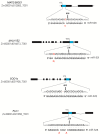MicroRNA Zma-miR528 Versatile Regulation on Target mRNAs during Maize Somatic Embryogenesis
- PMID: 34069987
- PMCID: PMC8157881
- DOI: 10.3390/ijms22105310
MicroRNA Zma-miR528 Versatile Regulation on Target mRNAs during Maize Somatic Embryogenesis
Abstract
MicroRNAs (miRNAs) are small non-coding RNAs that regulate the accumulation and translation of their target mRNAs through sequence complementarity. miRNAs have emerged as crucial regulators during maize somatic embryogenesis (SE) and plant regeneration. A monocot-specific miRNA, mainly accumulated during maize SE, is zma-miR528. While several targets have been described for this miRNA, the regulation has not been experimentally confirmed for the SE process. Here, we explored the accumulation of zma-miR528 and several predicted targets during embryogenic callus induction, proliferation, and plantlet regeneration using the maize cultivar VS-535. We confirmed the cleavage site for all tested zma-miR528 targets; however, PLC1 showed very low levels of processing. The abundance of zma-miR528 slightly decreased in one month-induced callus compared to the immature embryo (IE) explant tissue. However, it displayed a significant increase in four-month sub-cultured callus, coincident with proliferation establishment. In callus-regenerated plantlets, zma-miR528 greatly decreased to levels below those observed in the initial explant. Three of the target transcripts (MATE, bHLH, and SOD1a) showed an inverse correlation with the miRNA abundance in total RNA samples at all stages. Using polysome fractionation, zma-miR528 was detected in the polysome fraction and exhibited an inverse distribution with the PLC1 target, which was not observed at total RNA. Accordingly, we conclude that zma-miR528 regulates multiple target mRNAs during the SE process by promoting their degradation, translation inhibition or both.
Keywords: maize; miRNA-target regulation; somatic embryogenesis; zma-miR528.
Conflict of interest statement
The authors declare no conflict of interest. The funders had no role in the design of the study; in the collection, analyses, or interpretation of data; in the writing of the manuscript, or in the decision to publish the results.
Figures






Similar articles
-
Submergence-responsive MicroRNAs are potentially involved in the regulation of morphological and metabolic adaptations in maize root cells.Ann Bot. 2008 Oct;102(4):509-19. doi: 10.1093/aob/mcn129. Epub 2008 Jul 31. Ann Bot. 2008. PMID: 18669574 Free PMC article.
-
Development-Related miRNA Expression and Target Regulation during Staggered In Vitro Plant Regeneration of Tuxpeño VS-535 Maize Cultivar.Int J Mol Sci. 2019 Apr 27;20(9):2079. doi: 10.3390/ijms20092079. Int J Mol Sci. 2019. PMID: 31035580 Free PMC article.
-
The explant developmental stage profoundly impacts small RNA-mediated regulation at the dedifferentiation step of maize somatic embryogenesis.Sci Rep. 2019 Oct 10;9(1):14511. doi: 10.1038/s41598-019-50962-y. Sci Rep. 2019. PMID: 31601893 Free PMC article.
-
Maize somatic embryogenesis: recent features to improve plant regeneration.Methods Mol Biol. 2012;877:173-82. doi: 10.1007/978-1-61779-818-4_14. Methods Mol Biol. 2012. PMID: 22610628 Review.
-
Small but powerful: function of microRNAs in plant development.Plant Cell Rep. 2018 Mar;37(3):515-528. doi: 10.1007/s00299-017-2246-5. Epub 2018 Jan 9. Plant Cell Rep. 2018. PMID: 29318384 Review.
Cited by
-
Non-conserved microRNAs and their roles in plants: the case for legumes.Plant Biol (Stuttg). 2025 Jun;27(4):450-460. doi: 10.1111/plb.70027. Epub 2025 May 1. Plant Biol (Stuttg). 2025. PMID: 40311108 Free PMC article. Review.
-
Integrated analysis of transcriptome, sRNAome, and degradome involved in the drought-response of maize Zhengdan958.Open Life Sci. 2025 Jan 27;20(1):20221044. doi: 10.1515/biol-2022-1044. eCollection 2025. Open Life Sci. 2025. PMID: 39881824 Free PMC article.
-
Transcriptional Regulation of zma-MIR528a by Action of Nitrate and Auxin in Maize.Int J Mol Sci. 2022 Dec 11;23(24):15718. doi: 10.3390/ijms232415718. Int J Mol Sci. 2022. PMID: 36555358 Free PMC article.
-
MicroRNA528 and Its Regulatory Roles in Monocotyledonous Plants.Int J Mol Sci. 2025 Jul 29;26(15):7334. doi: 10.3390/ijms26157334. Int J Mol Sci. 2025. PMID: 40806465 Free PMC article. Review.
-
Epigenetic modifications and miRNAs determine the transition of somatic cells into somatic embryos.Plant Cell Rep. 2023 Dec;42(12):1845-1873. doi: 10.1007/s00299-023-03071-0. Epub 2023 Oct 4. Plant Cell Rep. 2023. PMID: 37792027 Review.
References
-
- Leljak-Levanić D., Mihaljević S., Bauer N. Somatic and zygotic embryos share common developmental features at the onset of plant embryogenesis. Acta Physiol. Plant. 2015;37:1–14. doi: 10.1007/s11738-015-1875-y. - DOI
-
- Elhiti M., Stasolla C., Wang A. Molecular regulation of plant somatic embryogenesis. In Vitro Cell Dev. Biol.-Plant. 2013;49:631–642. doi: 10.1007/s11627-013-9547-3. - DOI
MeSH terms
Substances
Grants and funding
LinkOut - more resources
Full Text Sources
Miscellaneous

